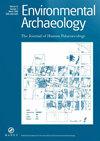什么咬了古埃及人?识别布鲁克林医学莎草纸中描述的蛇的小生境模型
IF 1.1
3区 地球科学
0 ARCHAEOLOGY
引用次数: 0
摘要
布鲁克林纸莎草是一份来自古埃及(约公元前660-330年)的关于蛇咬伤的医学论文。爬行动物学家已经提出了对它所描述的许多动物的鉴定,但有些仍然不确定,部分原因是这些物种不再生活在埃及。本文使用生态位模型来预测其中10种蛇的古分布,以测试一些提出的鉴定。利用发生记录和环境变量为现代和全新世中期(~ 4000 BCE)的每个物种生成最大熵模型。我们的模型表现非常好,生成的AUC得分≥0.867,并成功预测了物种的当前范围。9种预测的古分布包括古埃及地区,4种(Bitis arietans、Dolichophis jugularis、Macrovipera lebetina和Daboia mauritanica)位于现代埃及。据预测,巴勒斯坦大鳄也会在现代埃及境内占据一块合适的栖息地,但与该物种的核心范围分开。第十种是菱形蛇,它可能存在于古埃及人的常规贸易伙伴王国中。因此,我们得出结论,本研究中模拟的所有10种物种都可能咬过古埃及人。我们的研究证明了生态位模型在为关于古代文化可能与之相互作用的物种的辩论提供信息方面的有用性。我们感谢Gonzalo Sanchez, Nick Casewell, Tomáš Mazuch, Gordon W. Schuett, Stephen Spawls和David A. Warrell对蛇的分布和可能的候选物种进行了许多有启启性的讨论,以匹配布鲁克林纸莎草纸上的描述。我们没有得到这项研究的资助。披露声明作者未报告潜在的利益冲突。作者简介:谢丽莎·麦克布赖德谢丽莎·麦克布赖德毕业于班戈大学动物行为学专业。她的主要兴趣是动物行为和民族动物学。Isabelle C. Winder是班戈大学动物学高级讲师,对进化人类学和灵长类动物学感兴趣。她的研究探索了人类进化是如何通过与环境和其他生物的相互作用而形成的。Wolfgang w本文章由计算机程序翻译,如有差异,请以英文原文为准。
What Bit the Ancient Egyptians? Niche Modelling to Identify the Snakes Described in the Brooklyn Medical Papyrus
ABSTRACTThe Brooklyn Papyrus is a medical treatise from Ancient Egypt (∼660–330 BCE) focusing on snakebite. Herpetologists have proposed identifications for many of the animals it describes, but some remain uncertain partly because the species no longer live in Egypt. This paper uses niche modelling to predict the palaeodistributions of ten of these snake species, to test some proposed identifications. Occurrence records and environmental variables were used to generate maximum entropy models for each species in the present day and the mid-Holocene (∼4,000 BCE). Our models performed very well, generating AUC scores ≥0.867 and successfully predicting species’ current ranges. Nine species’ predicted palaeodistributions included areas within Ancient Egypt, and four (Bitis arietans, Dolichophis jugularis, Macrovipera lebetina and Daboia mauritanica) were within modern Egypt. Daboia palaestinae was also predicted to occupy a patch of suitable habitat inside modern Egypt, but separate from the species’ core range. The tenth species, Causus rhombeatus, would have been present in kingdoms that were the Ancient Egyptians’ regular trading partners. We therefore conclude that all ten species modelled in this study could have bitten Ancient Egyptian people. Our study demonstrates the usefulness of niche modelling in informing debates about the species ancient cultures may have interacted with.KEYWORDS: Ancient EgyptsnakesBrooklyn PapyrusMaxENTniche modellingpalaeodistributions AcknowledgementsWe thank Gonzalo Sanchez, Nick Casewell, Tomáš Mazuch, Gordon W. Schuett, Stephen Spawls and David A. Warrell for many enlightening discussions about snake distributions and possible candidate species to match the descriptions in the Brooklyn Papyrus. We received no funding for this research.Disclosure StatementNo potential conflict of interest was reported by the author(s).Additional informationNotes on contributorsElysha McBrideElysha McBride is a MZool graduate of Bangor University in Zoology with Animal Behaviour. Her main interests are in animal behaviour and ethnozoology.Isabelle C. WinderIsabelle C. Winder is a Senior Lecturer in Zoology at Bangor University interested in evolutionary anthropology and primatology. Her research explores how human evolution has been shaped by interactions with the environment and other organisms.Wolfgang WüsterWolfgang Wüster is a Professor in Zoology at Bangor University interested in herpetology and toxinology. His main research interests are the selective drivers of snake venom evolution, systematics, biogeography, conservation and addressing the public health issues caused by venomous snakebites.
求助全文
通过发布文献求助,成功后即可免费获取论文全文。
去求助
来源期刊

Environmental Archaeology
GEOSCIENCES, MULTIDISCIPLINARY-
CiteScore
4.80
自引率
0.00%
发文量
32
期刊介绍:
Environmental Archaeology: The Journal of Human Palaeoecology aims to publish contributions on all aspects of environmental archaeology, from methodology to synthesis and theory.
Environmental Archaeology is an international peer-reviewed periodical which welcomes contributions that consider the interaction between humans and their environment in the archaeological and historical past. This broad scope embraces papers covering a range of environmental specialisms within archaeology, such as archaeobotany, archaeozoology (both vertebrate and invertebrate), palynology, geoarchaeology, biological anthropology, as well as more synthetic and theoretical approaches to the past human environment. Assemblage and site reports are not encouraged unless these can demonstrate significant new insights in environmental archaeology. Contributions may take the form of substantial research papers or shorter reports and may include, for instance, new techniques, philosophical discussions, current controversies and suggestions for new research. The journal also provides its readership with critical appraisal of recent academic scholarship through its regular books review section.
 求助内容:
求助内容: 应助结果提醒方式:
应助结果提醒方式:


